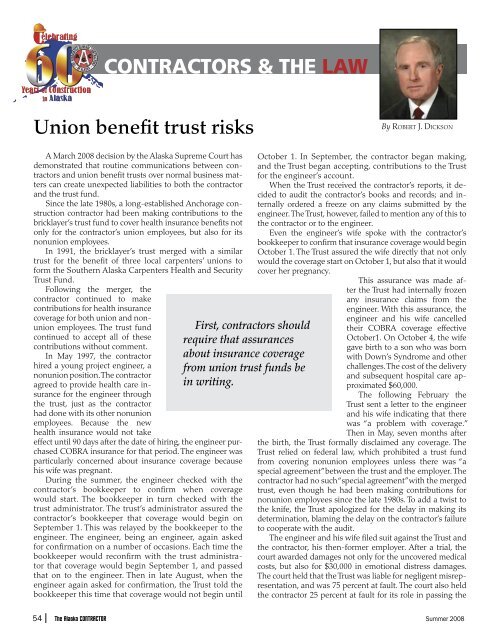The Alaska Contractor - Summer 2008
The Alaska Contractor - Summer 2008
The Alaska Contractor - Summer 2008
You also want an ePaper? Increase the reach of your titles
YUMPU automatically turns print PDFs into web optimized ePapers that Google loves.
CONTRACTORS & THE LAW<br />
Union benefit trust risks<br />
A March <strong>2008</strong> decision by the <strong>Alaska</strong> Supreme Court has<br />
demonstrated that routine communications between contractors<br />
and union benefit trusts over normal business matters<br />
can create unexpected liabilities to both the contractor<br />
and the trust fund.<br />
Since the late 1980s, a long-established Anchorage construction<br />
contractor had been making contributions to the<br />
bricklayer’s trust fund to cover health insurance benefits not<br />
only for the contractor’s union employees, but also for its<br />
nonunion employees.<br />
In 1991, the bricklayer’s trust merged with a similar<br />
trust for the benefit of three local carpenters’ unions to<br />
form the Southern <strong>Alaska</strong> Carpenters Health and Security<br />
Trust Fund.<br />
Following the merger, the<br />
contractor continued to make<br />
contributions for health insurance<br />
coverage for both union and nonunion<br />
employees. <strong>The</strong> trust fund<br />
continued to accept all of these<br />
contributions without comment.<br />
In May 1997, the contractor<br />
hired a young project engineer, a<br />
nonunion position. <strong>The</strong> contractor<br />
agreed to provide health care insurance<br />
for the engineer through<br />
the trust, just as the contractor<br />
had done with its other nonunion<br />
employees. Because the new<br />
health insurance would not take<br />
effect until 90 days after the date of hiring, the engineer purchased<br />
COBRA insurance for that period. <strong>The</strong> engineer was<br />
particularly concerned about insurance coverage because<br />
his wife was pregnant.<br />
During the summer, the engineer checked with the<br />
contractor’s bookkeeper to confirm when coverage<br />
would start. <strong>The</strong> bookkeeper in turn checked with the<br />
trust administrator. <strong>The</strong> trust’s administrator assured the<br />
contractor’s bookkeeper that coverage would begin on<br />
September 1. This was relayed by the bookkeeper to the<br />
engineer. <strong>The</strong> engineer, being an engineer, again asked<br />
for confirmation on a number of occasions. Each time the<br />
bookkeeper would reconfirm with the trust administrator<br />
that coverage would begin September 1, and passed<br />
that on to the engineer. <strong>The</strong>n in late August, when the<br />
engineer again asked for confirmation, the Trust told the<br />
bookkeeper this time that coverage would not begin until<br />
By ROBERT J. DICKSON<br />
October 1. In September, the contractor began making,<br />
and the Trust began accepting, contributions to the Trust<br />
for the engineer’s account.<br />
When the Trust received the contractor’s reports, it decided<br />
to audit the contractor’s books and records; and internally<br />
ordered a freeze on any claims submitted by the<br />
engineer. <strong>The</strong> Trust, however, failed to mention any of this to<br />
the contractor or to the engineer.<br />
Even the engineer’s wife spoke with the contractor’s<br />
bookkeeper to confirm that insurance coverage would begin<br />
October 1. <strong>The</strong> Trust assured the wife directly that not only<br />
would the coverage start on October 1, but also that it would<br />
cover her pregnancy.<br />
This assurance was made after<br />
the Trust had internally frozen<br />
any insurance claims from the<br />
engineer. With this assurance, the<br />
engineer and his wife cancelled<br />
First, contractors should their COBRA coverage effective<br />
require that assurances<br />
October1. On October 4, the wife<br />
gave birth to a son who was born<br />
about insurance coverage<br />
with Down’s Syndrome and other<br />
from union trust funds be challenges. <strong>The</strong> cost of the delivery<br />
and subsequent hospital care ap-<br />
in writing.<br />
proximated $60,000.<br />
<strong>The</strong> following February the<br />
Trust sent a letter to the engineer<br />
and his wife indicating that there<br />
was “a problem with coverage.”<br />
<strong>The</strong>n in May, seven months after<br />
the birth, the Trust formally disclaimed any coverage. <strong>The</strong><br />
Trust relied on federal law, which prohibited a trust fund<br />
from covering nonunion employees unless there was “a<br />
special agreement” between the trust and the employer. <strong>The</strong><br />
contractor had no such “special agreement” with the merged<br />
trust, even though he had been making contributions for<br />
nonunion employees since the late 1980s. To add a twist to<br />
the knife, the Trust apologized for the delay in making its<br />
determination, blaming the delay on the contractor’s failure<br />
to cooperate with the audit.<br />
<strong>The</strong> engineer and his wife filed suit against the Trust and<br />
the contractor, his then-former employer. After a trial, the<br />
court awarded damages not only for the uncovered medical<br />
costs, but also for $30,000 in emotional distress damages.<br />
<strong>The</strong> court held that the Trust was liable for negligent misrepresentation,<br />
and was 75 percent at fault. <strong>The</strong> court also held<br />
the contractor 25 percent at fault for its role in passing the
















